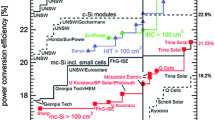Abstract
This article presents effective utilization of light by transparent conducting oxide (TCO) layer to enhance the performance of c-Si/a-Si:H heterojunction solar cells (HJSC) by simulation. The optical and recombination losses in solar cells severely deteriorate the short circuit density (Jsc), open circuit voltage (Voc) and then efficiency (η) of the solar cells. In order to reduce the optical losses, recombination losses and to improve the efficiency of solar cell devices, the c-Si/a-Si:H HJSC performance was investigated by planner and textured indium tin oxide (ITO) and zinc oxide (ZnO) layers as front TCO layer with AFORSHET simulations tool. Absorption and reflection spectra of ITO and ZnO layers were analysed separately before incorporating in to the c-Si/a-Si:H HJSC. The estimated solar cell parameter values of 763.7 mV, 40.96 mA cm−2, 85.91% and 26.86% correspond to Voc, Jsc, FF (fill factor) and η respectively for the cells with plane ZnO layers. It is found that the best values of Voc (763.7 mV), Jsc (41.87 mA cm−2), FF (85.91%) and η (27.47%) were obtained with textured ZnO layer. This is mainly due to reduced reflection losses and also increased absorption of photons in c-Si wafer with texturing of TCO layer, which results in increase of short circuit density of solar cells. The efficiency of solar cells with ITO is slightly lower than the ZnO layer.






Similar content being viewed by others
References
De Wolf S, Descoeudres A, Holman Z C and Ballif C 2012 Green 2 7
Ramanujam J and Verma A 2012 Mater. Express 2 177
Wilfried G J H M and van Sark L K 2012 Physics and technology of amorphouscrystalline heterojunction silicon solar cells (Berlin, Heidelberg: Springer), https://doi.org/10.1007/978-3-642-22275-7
Tuna O, Selamet Y, Aygun G and Ozyuzer L 2010 J. Phys. D Appl. Phys. 43 055402
Fan Q H, Chen C, Liao X, Xiang X, Cao X, Ingler W et al 2010 J. Appl. Phys. 107 034505
Ryu H, Kang J, Han Y, Kim D, Pak J J, Park W K et al 2003 J. Electron. Mater. 32 919
Aouaj M A, Diaz R, Belayachi A, Rueda F and Abd-Lefdil M 2009 Mater. Res. Bull. 44 1458
Zhu B L, Zhu S J, Wang J, Wu J, Zeng D W and Xie C S 2011 Phys. E Low-Dimens. Syst. Nanostruct. 43 1738
Lien S-Y 2010 Thin Solid Films 518 S10
Kulkarni A K, Schulz K H, Lim T-S and Khan M 1997 Thin Solid Films 1 308
Cruz A, Wang E C, Morales-Vilches A B, Meza D, Neubert S, Szyszka B et al 2019 Sol. Energy Mater. Sol. Cells 195 339
Bendjebbar K, Rahal W L, Rached D and Bahlouli S 2020 Optik (Stuttg) 212 164741
Kanneboina V, Basumatary P and Agarwal P 2019 AIP Conf. Proc. 2091 020016
Kanneboina Venkanna, Madaka Ramakrishna and Agarwal P 2018 Sol. Energy 166 255
Yao Y, Xu X, Zhang X, Zhou H, Gu X and Xiao S 2018 Mater. Sci. Semicond. Process. 77 16
Singh S, Kumar S and Dwivedi N 2012 Sol. Energy 86 1470
Dwivedi N, Kumar S, Bisht A, Patel K and Sudhakar S 2013 Sol. Energy 88 31
Madaka R, Kanneboina V and Agarwal P 2018 Thin Solid Films 662 155
Masuko K, Shigematsu M, Hashiguchi T, Fujishima D, Kai M, Yoshimura N et al 2014 IEEE J. Photovolt. 4 1433
Taguchi M, Yano A, Tohoda S, Matsuyama K, Nakamura Y, Nishiwaki T et al 2014 IEEE J. Photovolt. 4 96
Huang H, Tian G, Zhou L, Yuan J, Fahrner W R, Zhang W et al 2018 Chin. Phys. B 27 038502
Varache R, Leendertz C, Gueunier-Farret M E, Haschke J, Muñoz D and Korte L 2015 Sol. Energy Mater. Sol. Cells 141 14
Zhao L, Zhou C L, Li H L, Diao H W and Wang W J 2008 Sol. Energy Mater. Sol. Cells 92 673
Wen X, Zeng X, Liao W, Lei Q and Yin S 2013 Sol. Energy 96 168
Stangl R, Kriegel M and Schmidt M 2007 In AFORS-HET, version 2.2, conf. rec. 2006 IEEE 4th world conf. photovolt. energy conversion WCPEC-4 vol 2 p 1350
Stangl R, Kriegel M, Maydell K V, Korte L, Schmidt M and Fuhs W 2005 In A conf. rec. IEEE photovolt. spec. conf. p 1556
Kanneboina Venkanna 2021 J. Comput. Electron. 20 344
Ide Y, Saito Y, Yamada A and Konagai M 2004 Jpn. J. Appl. Phys. 43 2419
Stangl R, Leendertz C and Haschke J 2010 in Solar Energy Rugescu R D (ed) (IntechOpen), https://doi.org/10.5772/8073
Fonash S J 2010 Solar cell device physics 2nd edn (Amsterdam: Elsevier) https://doi.org/10.1016/0025-5408(82)90173-8
Schropp R E I and Zeman M 1998 Amorphous and microcrystalline silicon solar cells: Modeling, materials and device technology (Berlin, Heidelberg: Springer) https://doi.org/10.1007/978-1-4615-5631-2
Iftiquar S M, Park H, Kim S and Yi J 2020 Sol. Energy Mater. Sol. Cells 204 110238
Acknowledgements
We acknowledge the Helmholtz-Zentrum Berlin for providing AFORS-HET simulation software.
Author information
Authors and Affiliations
Corresponding author
Rights and permissions
About this article
Cite this article
Kanneboina, V. Effective utilization of light by transparent conducting oxide layer to enhance the performance of the silicon heterojunction solar cells. Bull Mater Sci 44, 233 (2021). https://doi.org/10.1007/s12034-021-02534-y
Received:
Accepted:
Published:
DOI: https://doi.org/10.1007/s12034-021-02534-y




